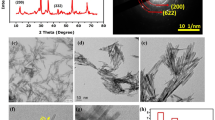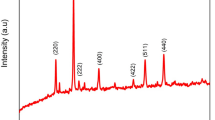Abstract
Transiontion-metal chalcogenides (TMCs) have attracted increasing attention in electrochemical energy storage over recent years. As an important member of the TMC family, VS4 has many intriguing chemical and physical properties benefited from the peculiar crystallographic structure. Herein, novel VS4 nanorods with a diameter of 30–100 nm were successfully synthesized by a facile solvothermal method, which showed a tremendous specific capacitance of 617 F/g at 0.4 A/g in a solution of 1 M LiNO3 using a three-electrode system. The obtained energy density was as high as 55 Wh/kg, which was much higher than those of many other symmetrical supercapacitors. Most remarkably, the capacity retention of 87.5% was achieved even after 1500 cycles at a current density of 3 A/g. The results infer that the material has the potential to be used as a high performance supercapacitor electrode.
Access this chapter
Tax calculation will be finalised at checkout
Purchases are for personal use only
Similar content being viewed by others
References
Shao Y et al (2018) Design and mechanisms of asymmetric supercapacitors. Chem Rev 118(18):9233–9280
Jayaramulu K et al (2018) Ultrathin hierarchical porous carbon nanosheets for high-performance supercapacitors and redox electrolyte energy storage. Adv Mater 30(15):e1705789
Du J et al (2019) Mesoporous carbon sheets embedded with vesicles for enhanced supercapacitor performance. J Mater Chem A 7(26):15707–15713
Ren L et al (2019) Growth of PANI thin layer on MoS2 nanosheet with high electro-capacitive property for symmetric supercapacitor. J Alloy Compd 798:227–234
Ghorai A, Midya A, Ray SK (2018) Superior charge storage performance of WS2 quantum dots in a flexible solid state supercapacitor. New J Chem 42(5):3609–3613
Parveen N et al (2018) Facile synthesis of SnS2 nanostructures with different morphologies for high-performance supercapacitor applications. ACS Omega 3(2):1581–1588
Ratha S et al (2015) Supercapacitors based on patronite-reduced graphene oxide hybrids: experimental and theoretical insights. J Mater Chem A 3(37):18874–18881
Wang S et al (2019) Efficient trap** and catalytic conversion of polysulfides by VS4 nanosites for Li–S batteries. ACS Energ Lett 4(3):755–762
Lian R et al (2019) Nucleation and conversion transformations of the transition metal polysulfide VS4 in lithium-ion batteries. ACS Appl Mater Interfaces 11(25):22307–22313
Ratha S et al (2016) High-energy-density supercapacitors based on patronite/single-walled carbon nanotubes/reduced graphene oxide hybrids. Eur J Inorg Chem 2016(2):259–265
Wang Y et al (2018) Highly branched VS4 nanodendrites with 1D atomic-chain structure as a promising cathode material for long-cycling magnesium batteries. Adv Mater 30(32):e1802563
Li W et al (2018) Controlled construction of 3D self-assembled VS 4 nanoarchitectures as high-performance anodes for sodium-ion batteries. Electrochim Acta 274:334–342
Mondal A, Das S, Manam J (2019) Investigation on spectroscopic properties and temperature dependent photoluminescence of NIR emitting Cr3 + doped zinc gallate long persistent nanophosphor. Physica B 569:20–30
Yang G et al (2018) High-crystallinity urchin-like VS4 anode for high-performance lithium-ion storage. ACS Appl Mater Interfaces 10(17):14727–14734
Yang G et al (2019) Superior li-ion storage of VS4 nanowires anchored on reduced graphene. Nanoscale 11(19):9556–9562
Rantho MN et al (2018) Asymmetric supercapacitor based on vanadium disulfide nanosheets as a cathode and carbonized iron cations adsorbed onto polyaniline as an anode. Electrochim Acta 260:11–23
Feng J et al (2011) Metallic few-layered VS2 ultrathin nanosheets: high two-dimensional conductivity for in-plane supercapacitors. J Am Chem Soc 133(44):17832–17838
Bai X et al (2017) All-solid state asymmetric supercapacitor based on NiCoAl layered double hydroxide nanopetals on robust 3D graphene and modified mesoporous carbon. Chem Eng J 328:873–883
Rakhi RB et al (2016) Supercapacitors based on two dimensional VO 2 nanosheet electrodes in organic gel electrolyte. Electrochim Acta 220:601–608
Ji H-M et al (2019) Highly active free-standing and flexible MoS2/rGO sandwich-structured films for supercapacitor applications. Solid State Commun 297:45–49
Chen W et al (2019) Hierarchical architecture of coupling graphene and 2D WS2 for high-performance supercapacitor. Electrochim Acta 298:313–320
Youe WJ et al (2018) MnO2-deposited lignin-based carbon nanofiber mats for application as electrodes in symmetric pseudocapacitors. Int J Biol Macromol 112:943–950
Abureden S et al (2017) Reconciled nanoarchitecture with overlapped 2D anatomy for high-energy hybrid supercapacitors. Energ Technol 5(11):1919–1926
Masikhwa TM et al (2016) Asymmetric supercapacitor based on VS2 nanosheets and activated carbon materials. RSC Adv 6(45):38990–39000
Acknowledgements
This work was financially supported by National Natural Science Foundation of China (Nos. 51474041, 51674051), and Fundamental Research Funds for the Central Universities of China (106112015CDJZR465505, cqu2017hbrc1B08).
Author information
Authors and Affiliations
Corresponding author
Editor information
Editors and Affiliations
Rights and permissions
Copyright information
© 2020 The Minerals, Metals & Materials Society
About this paper
Cite this paper
Feng, JK., Huang, J., Li, HY., **e, B. (2020). Novel VS4 Nanorods Synthesized by a Facile Solvothermal Method for High Performance Electrochemical Capacitor Electrode. In: TMS 2020 149th Annual Meeting & Exhibition Supplemental Proceedings. The Minerals, Metals & Materials Series. Springer, Cham. https://doi.org/10.1007/978-3-030-36296-6_141
Download citation
DOI: https://doi.org/10.1007/978-3-030-36296-6_141
Published:
Publisher Name: Springer, Cham
Print ISBN: 978-3-030-36295-9
Online ISBN: 978-3-030-36296-6
eBook Packages: Chemistry and Materials ScienceChemistry and Material Science (R0)




